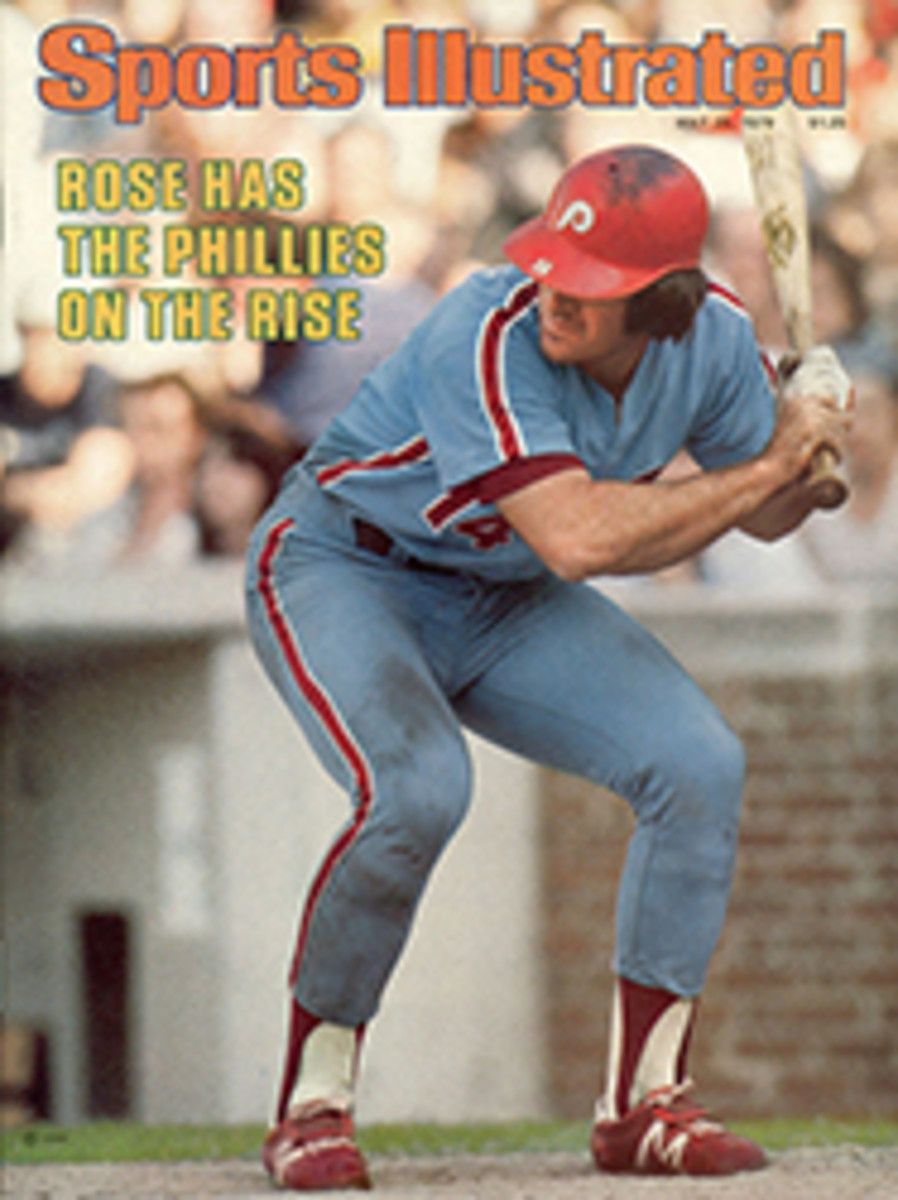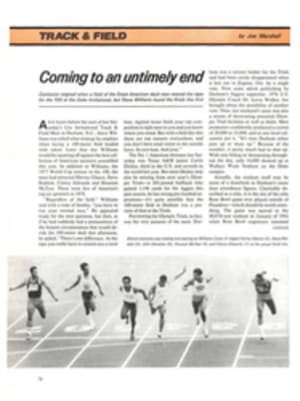
SCORECARD
UNSETTLING
The presidents of the American and National leagues and the Umpires Association last week settled on a new three-year contract. It brought the 52 striking umps back to work after 45 days, 474 games and countless questionable (or worse) calls by their substitutes.
The men in blue and red made some nice gains. They received raises averaging about $7,000 a year, increases in per diem expenses, and two-week vacations during the season. The cost to baseball over the length of the pact will be $2½ million, or about a million more than it would have cost if the presidents had settled before the season. However, there is one unsettling clause. In case of a player strike next year, umpires will be paid for the first 30 days. If the strike lasts all season, they will be paid for 60 days. Thirty days? All season? Let's hope that that clause represents lawyers' caution and not well-based fears.
GREAT IDEAS OF WESTERN MAN
Dave Romero is a man with a dump truck and a dream. Inspired by the exploits of Evel Knievel, who made his mark jumping over trucks on his motorcycle, Romero wants to fly over motorcycles in his dump truck, 18 cycles, to be precise, a distance of about 60 feet.
In order to land safely, Romero has calculated that he will have to reach a minimum of 140 mph in his 10-ton Ken-worth dump truck, but he has yet to determine the length, height and angle of the takeoff and landing ramps. The stunt will cost upwards of $50,000, which doesn't include the motorcycles or insurance. That explains the advertisements that have been appearing recently in such papers as Western Truck Trader, setting forth the prospective stunt along with a phone number to call anytime, because Romero is looking for financial backing. A Southern California truck dealer has offered him $150,000, but Romero is holding out for more. The tentative jump date is sometime in August, and he says he'll do it wherever he can get the most money.
"I've been a trucker all my life," says Romero, age 32, who owns a small trucking business in Albuquerque. "If there's anything that can be done with a truck, well, I'm your man. I've never performed a stunt before, but I've been practicing in private and I'm 100% sure I'll make it."
"Think about it," Dave Romero's advertisement proclaims. "It's a great idea."
Perhaps.
FILL 'EM UP
Johnny Rodgers, the former Heisman Trophy winner from Nebraska and now a wide receiver for the San Diego Chargers, owns a Rolls-Royce, a Jensen-Healey and a Mercedes, and has also been seen driving a van. Apparently frustrated and aggravated by the long lines for gasoline in Southern California, he found a solution. He bought the ARCO station at Alice Street and El Cajon Boulevard in San Diego.
A WORD OF CAUTION
Last month, on an unlit country road in Brookhaven, N.Y., two bicylists out for evening rides collided head on. One thought he had crashed into a tree, until he woke up in a hospital and was told otherwise. He had a broken vertebra in his neck and was put in traction. The other was in a coma for two weeks before dying.
Police estimated that both were going about 20 mph, a speed on impact of 40 mph. Neither was equipped with a light, neither wore a helmet. Their bikes had reflectors, but there was no available light to be reflected.
Fatalities are rare in such accidents, but bike vs. bike collisions are fairly common. And according to a recent report by the National Electronic Injury Surveillance System of the Consumer Product Safety Commission, cycling is the most dangerous athletic activity in America. Last year there were 446,878 hospital-treated injuries involving bikes, compared with 399,874 in baseball, 394,827 in football and 349,760 in basketball. Most states have laws requiring that a bike be equipped with a light or reflective material and a bell or horn, but enforcement is seldom strict.
The government report doesn't state how many of the cycling accidents involved motor vehicles, but it's clear that cars are not the only moving hazards a cyclist must beware of.
FINANCIALLY FIT
Joseph J. McCann, recreation and parks director for Maryland's Anne Arundel County, likes to inject a little fun into dreary budget proceedings. Two years ago he appeared before the County Council wearing a boxing robe and gloves and ready, he said, to "fight" for his requests. He had the theme from Rocky playing in the background. Last year he brought along one of his employees dressed in a soccer referee's uniform and handed out "penalties" to any councilman who threatened cuts.
Last week, with a symbolic page of his $3 million department budget pinned to his T shirt, McCann, 35, 6'1" and 200 pounds, ran eight miles from his office to the Arundel Center courtyard in Annapolis and presented himself before the council. It was the "Joe McCann Budget Fun Run" and he had covered the distance in 56:56, more than three minutes under the goal that he had announced.
"I told them they couldn't cut my budget if I made it in an hour," he said. "Now, I'm going to tell them they have to give me $100,000 for each minute I shaved off."
He will get his answer in a week and the council would be well advised to be cooperative. McCann is an ex-linebacker at West Chester State College and there's no telling what stunt—or councilman—he'll tackle next year.
CITIUS, ALTIUS, GASTRITIS
Those who think athletes dine on nothing but fig potassium bars and prune yogurt should examine a new paperback book, 1980 Olympic Games in Moscow Cookbook and Schedule of Events (Wm. C. Brown Company, Dubuque, Iowa, $5). In a mere 160 pages, the reader gets schedules for 23 sports at the Moscow Games plus 384 "favorite recipes of prospective U.S. participants."
These dishes include Cincinnati chili (Archer Darrell Pace), quick meatball casserole (Sprinter Steve Riddick) and pineapple coffee bread (Basketball Player Kiki Vandeweghe). But the choice contributions are from Ambrose (Rowdy) Gaines IV, who offers these delicacies: butterscotch krunchies, pineapple burgers with spicy sauce and Calcutta curry.
Gaines specializes in swimming the 100- and 200-meter freestyle, but by the summer of 1980 he may be a super heavyweight weight lifter.
AND HERE COMES ARBITRARY!
An anonymous blonde showed up at Pimlico on Monday, May 14 lugging a briefcase bulging with packets of $50 and $100 bills totaling $60,000. She bet the entire wad to show on Dave's Friend, an odds-on favorite in the eighth race. A mutuel clerk took care of $20,000 of the bet and the money room handled the rest. It took about 30 minutes to punch out 1,200 $50 tickets. The horse won and Ms. Anon. collected $2.10 for $2, or a profit of $3,000.
The mystery blonde, who is rotund and of medium height, with her hair in a bun atop her head, visited Pimlico again on Friday. This time she wanted to bet $60,000 to show on Davona Dale, the 1-10 favorite who won the Black-Eyed Susan. She also announced plans for a huge show bet on Spectacular Bid in the Preakness. But she couldn't get down on either horse because the Thoroughbred Racing and Protective Board, calling Ms. Anon, an "undesirable person," banned her from all Maryland tracks. Gary Fichter, the agent in charge of the Pimlico branch of the TRPB, maintained that "under the law" tracks can exclude anyone deemed undesirable, but he insisted it isn't done arbitrarily.
The blonde may have become undesirable when her $60,000 bet on Dave's Friend caused a minus show pool, obliging Pimlico to shell out $11,576.85 of its own money. Unless the TRPB has more evidence of undesirability than betting large sums of money it would seem that arbitrary is indeed the word for this particular ban.
GARDEN PLAN
George Allen may have liked his players old and experienced, but he prefers his fruits and vegetables young and tender. Instead of a game plan, the unemployed coach now has a garden plan. "You've got to have one to space your production," he says. His two-acre plot at his home in Palos Verdes Estates, Calif. is equipped with a time-controlled underground irrigation and fertilization system, and Allen gardens with much of the zeal he used to exhibit in football. He may even lick his thumb.
Allen does the planting, hoeing, raking, weeding and picking. His strawberries are planted on a slope and serve as ground cover, and this year he already has a bumper crop. He grows zucchini, cucumbers, cantaloupes, watermelons, peas, green beans, parsnips, carrots, tomatoes, parsley and several varieties of lettuce, all as carefully arranged as the X's and O's on a blackboard. Last weekend Allen was putting in corn. "You have to keep vegetables coming to the table in orderly fashion," he says.
In addition, Allen has an orchard that yields oranges, grapefruits, tangerines, tangelos, limes, nectarines, avocados, peaches, plums, apples, persimmons, apricots and figs; a berry patch containing raspberries, boysenberries and blackberries; and 20 vines with Concord and muscatel grapes. Says George, "I like to see things grow."
LICENSE TO YELL
In a colorful debate in the Arizona legislature, members representing Phoenix proposed that the state's automobile license plates (formerly coppery orange and pale green) be painted maroon and gold, which just happen to be the colors of the local university, Arizona State. This didn't sit well with the lawmakers from Tucson, home of the University of Arizona Wildcats, whose colors are red and blue.
The representatives from Phoenix had more votes and, just to make a point after touchdown, they proposed putting ASU's Sun Devil symbol on the plates, too. Cooler heads, espousing separation of college and state, killed that idea.
The State Department of Transportation, which has final authority in the design of license plates, decided not to get caught between gangs of rabid alumni. Sheet aluminum painted maroon already had been ordered, so the bureaucrats figured they would make the numerals white. As The Arizona Daily Star wrote, at least Texas A&M fans will be happy.
HORSEHIDE HOLIDAY
If-it's-Tuesday-it-must-be-Veterans-Stadium Dept.: Bill Schroeder, director of the Citizens Savings Athletic Foundation in Los Angeles, has announced his ninth annual Baseball Safari. A fan following the itinerary will be able to see all 26 major league teams in 14 days without seeing any team twice, not even the Minnesota Twins.
Here are the stops: Aug. 24, San Diego; 25, Los Angeles; 26, San Francisco; 27, Montreal; 28, Philadelphia; 29, 30, New York; 31, Boston; Sept. 1, Baltimore; 2, Toronto; 3, Cleveland; 4, a travel day; 5, Oakland, and 6, Anaheim.
No one, including Schroeder himself, has ever gone on one of his cross-country safaris.
ILLUSTRATION
THEY SAID IT
•Herman Sarkowsky, treasurer of the Portland Trail Blazers, on Bill Walton's jump to San Diego: "Next year we'll get to see him at least twice in Portland. That's more than we saw him this year."
•Dave Heaverlo, Oakland relief pitcher, offering his plan to solve the California gasoline crunch and the A's poor attendance: "Open a service station in centerfield."
•Elvin Bethea, Houston Oiler All-Pro defensive end, unimpressed that his team spent its first two draft choices on defensive ends: "We don't know if our line will be better, but at least it will be longer."

